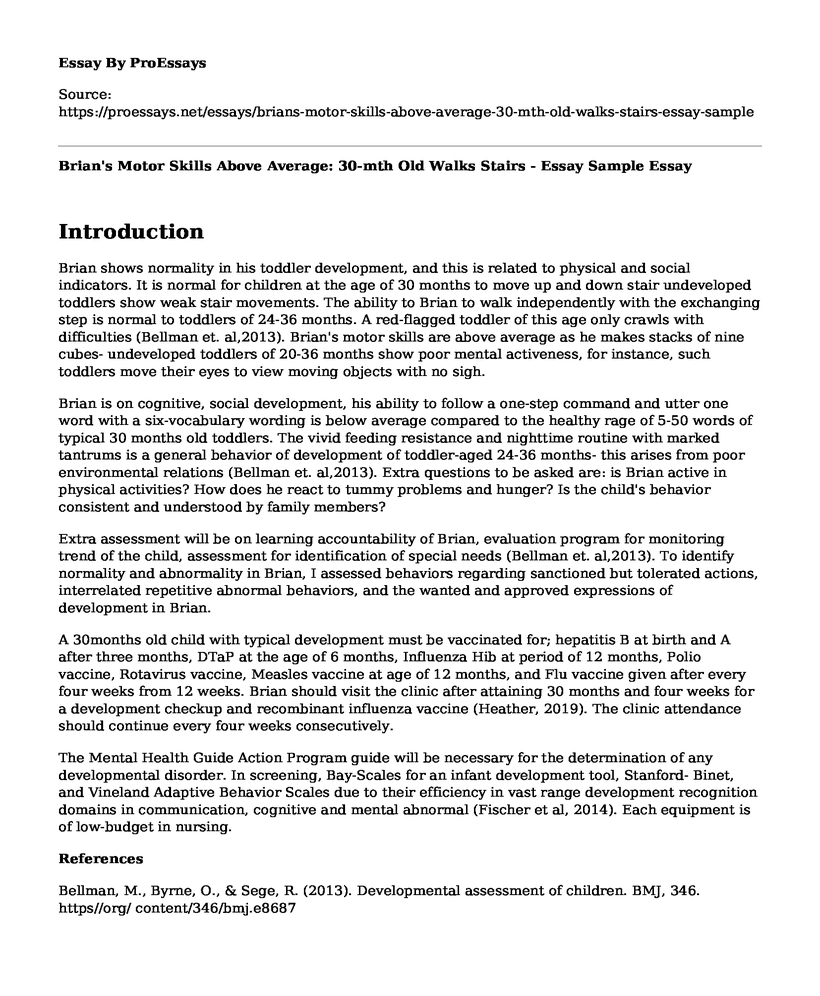Introduction
Brian shows normality in his toddler development, and this is related to physical and social indicators. It is normal for children at the age of 30 months to move up and down stair undeveloped toddlers show weak stair movements. The ability to Brian to walk independently with the exchanging step is normal to toddlers of 24-36 months. A red-flagged toddler of this age only crawls with difficulties (Bellman et. al,2013). Brian's motor skills are above average as he makes stacks of nine cubes- undeveloped toddlers of 20-36 months show poor mental activeness, for instance, such toddlers move their eyes to view moving objects with no sigh.
Brian is on cognitive, social development, his ability to follow a one-step command and utter one word with a six-vocabulary wording is below average compared to the healthy rage of 5-50 words of typical 30 months old toddlers. The vivid feeding resistance and nighttime routine with marked tantrums is a general behavior of development of toddler-aged 24-36 months- this arises from poor environmental relations (Bellman et. al,2013). Extra questions to be asked are: is Brian active in physical activities? How does he react to tummy problems and hunger? Is the child's behavior consistent and understood by family members?
Extra assessment will be on learning accountability of Brian, evaluation program for monitoring trend of the child, assessment for identification of special needs (Bellman et. al,2013). To identify normality and abnormality in Brian, I assessed behaviors regarding sanctioned but tolerated actions, interrelated repetitive abnormal behaviors, and the wanted and approved expressions of development in Brian.
A 30months old child with typical development must be vaccinated for; hepatitis B at birth and A after three months, DTaP at the age of 6 months, Influenza Hib at period of 12 months, Polio vaccine, Rotavirus vaccine, Measles vaccine at age of 12 months, and Flu vaccine given after every four weeks from 12 weeks. Brian should visit the clinic after attaining 30 months and four weeks for a development checkup and recombinant influenza vaccine (Heather, 2019). The clinic attendance should continue every four weeks consecutively.
The Mental Health Guide Action Program guide will be necessary for the determination of any developmental disorder. In screening, Bay-Scales for an infant development tool, Stanford- Binet, and Vineland Adaptive Behavior Scales due to their efficiency in vast range development recognition domains in communication, cognitive and mental abnormal (Fischer et al, 2014). Each equipment is of low-budget in nursing.
References
Bellman, M., Byrne, O., & Sege, R. (2013). Developmental assessment of children. BMJ, 346. https//org/ content/346/bmj.e8687
Fischer, V. J., Morris, J., & Martines, J. (2014). Developmental screening tools: feasibility of use at primary healthcare level in low-and middle-income settings-Journal of health, population, and nutrition, 32(2), 314. https//org/ gov/pubmed/25076668
Heather Calvin- Centers for Disease Control and Prevention. (2019). Catch-up immunization schedule for persons aged four months-18 years who start late or who are more than one month behind-United States. 2019.https//org/gov/vaccines/schedules/catchup.html.
Cite this page
Brian's Motor Skills Above Average: 30-mth Old Walks Stairs - Essay Sample. (2023, Apr 10). Retrieved from https://proessays.net/essays/brians-motor-skills-above-average-30-mth-old-walks-stairs-essay-sample
If you are the original author of this essay and no longer wish to have it published on the ProEssays website, please click below to request its removal:
- Licensed Practicing Nursing Career Plan Example
- The Use of Steroids by Professional Athletes to Boost Their Performance Raises Research
- Public Health Campaign - Research Paper
- STD at an Alarming Rate of Adults Paper Example
- Essay Sample on Reproductive System Disorders
- The Freedom to Be Me Essay Example
- Essay Example on Fast Food in Hospitals: Pros & Cons







